
Welcome to function following form in the purest possible way. This is another great example of grassroots time attacking – a machine that has been finely tuned for the sole purpose of cutting fast lap times around circuits like Mobara and Tsukuba.
I’ve been meaning to check out some of Garage WORK’s cars for a while now, as over the past few years their reputation for building fast Honda Civics has increased exponentially. The wild signature aero that’s applied to every Honda they wave their tuning wand over make these cars instantly recognisable as the work of Iwata-san, the man behind the small specialty shop. Iwata ended up damaging his EG Civic pretty badly the day before the final Battle Evome meet of the year, which is truly a pity as it’s the fastest FF car to have ever lapped Tsukuba. The Civic’s staggeringly-quick time – a 58″138 – beats out the previous FF record set by Ooi-san in the 5Zigen turbo DC5 Integra when he ran 58″222 back in 2009. Impressive stuff, right? Iwata-san has yet to decide if he’ll repair the Civic or start afresh with a new chassis, but rest assured that he’ll be back.

That’s the price you pay at these levels, I guess. The important thing is not getting hurt… While the EG6 is pretty much classified as a Garage WORK shop demo car, the EK4 you see here is not. Iwata has helped with the Civic SiR build, but for the most part it’s been pieced together by its owner, Makoto-san.

It’s the quintessential do-it-yourself weekend time attack racer, and one that is built around a number of inspiring details.

Makoto’s car was one of two EK Civics in the Tsukuba paddock for the Battle Evome event, and while I’ve already Spotlighted the white car, this build – despite being that of a privateer – really piqued my interest.
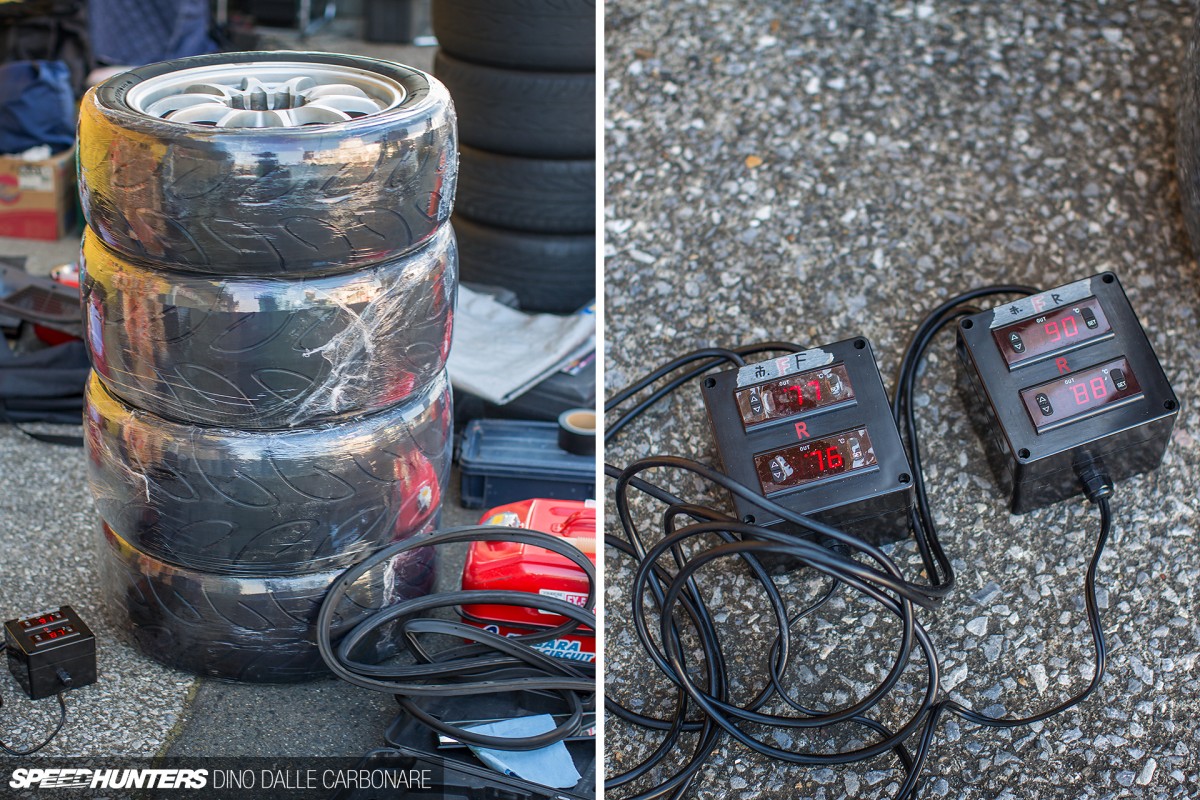
Like a lot of other competitors at these events now, Makoto takes his time attacking very seriously. That means multiple sets of tyres on hand, and some warmers to keep them nice and toasty. With four separate classes spread across the 2-hour session, you don’t get much time out on the track at Battle Evome, so every lap counts.

Let’s start off at the front end, where it’s impossible to ignore the wild diffuser, splitter and canard treatment that the C-West bumper has been majorly enhanced with.

There’s no real science here, it’s all experimental and very much trial and error. It’s also a fun way to learn about aerodynamics and the the effects that different upgrades have on the handling. Of course, the ultimate goal in this instance is to push the heavy front end down to the ground, allowing the tyres to find their maximum grip.
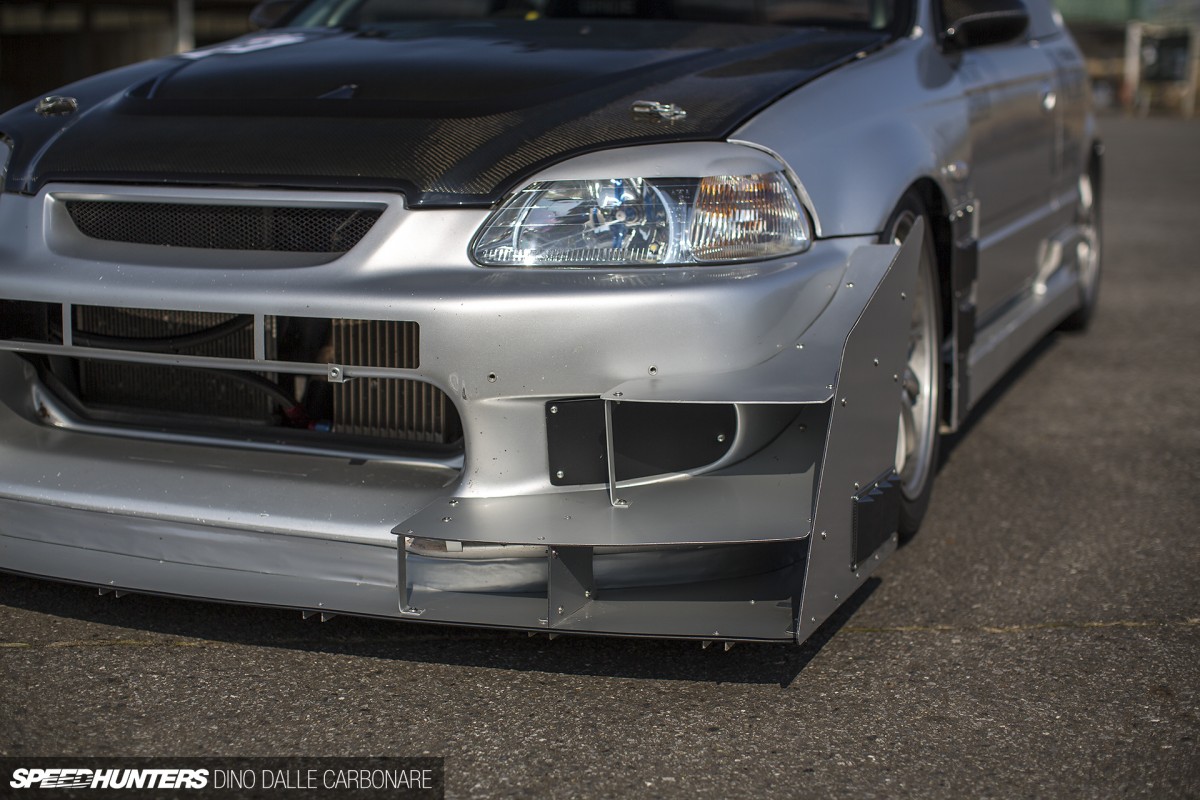
The front end aero comprises of an under-panel section connected up to two curved canards with a pair of upright and contoured end plates. The wings generate serious downforce at speed, which allows greater pace through the faster corners – like the long and tricky final turn at Tsukuba.
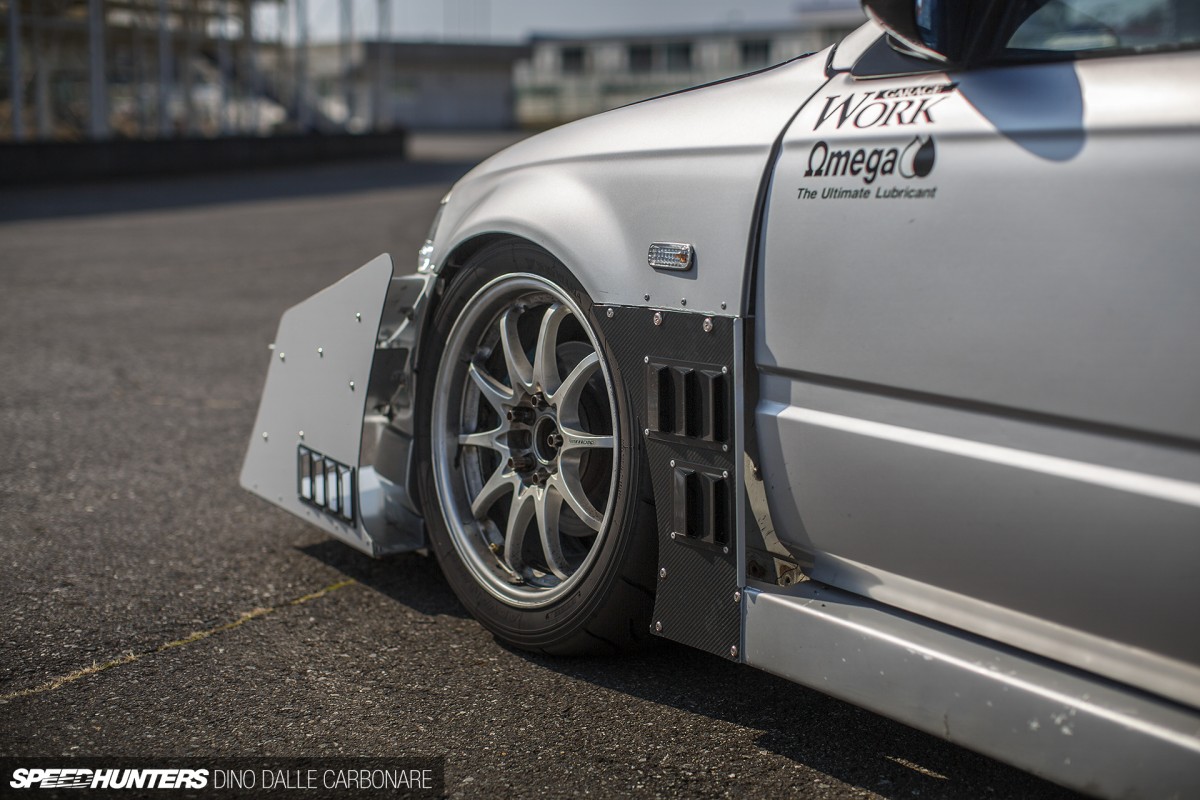
Makoto has also pushed out the stock fenders using extended lower mountings, which has created openings on each side of the car to channel turbulent air away from the wheel arches.

He’s even cut away the lower section and added some bolt-on louvers to accentuate the effect. The inspiration here comes from what GT cars have been running for well over a decade now.
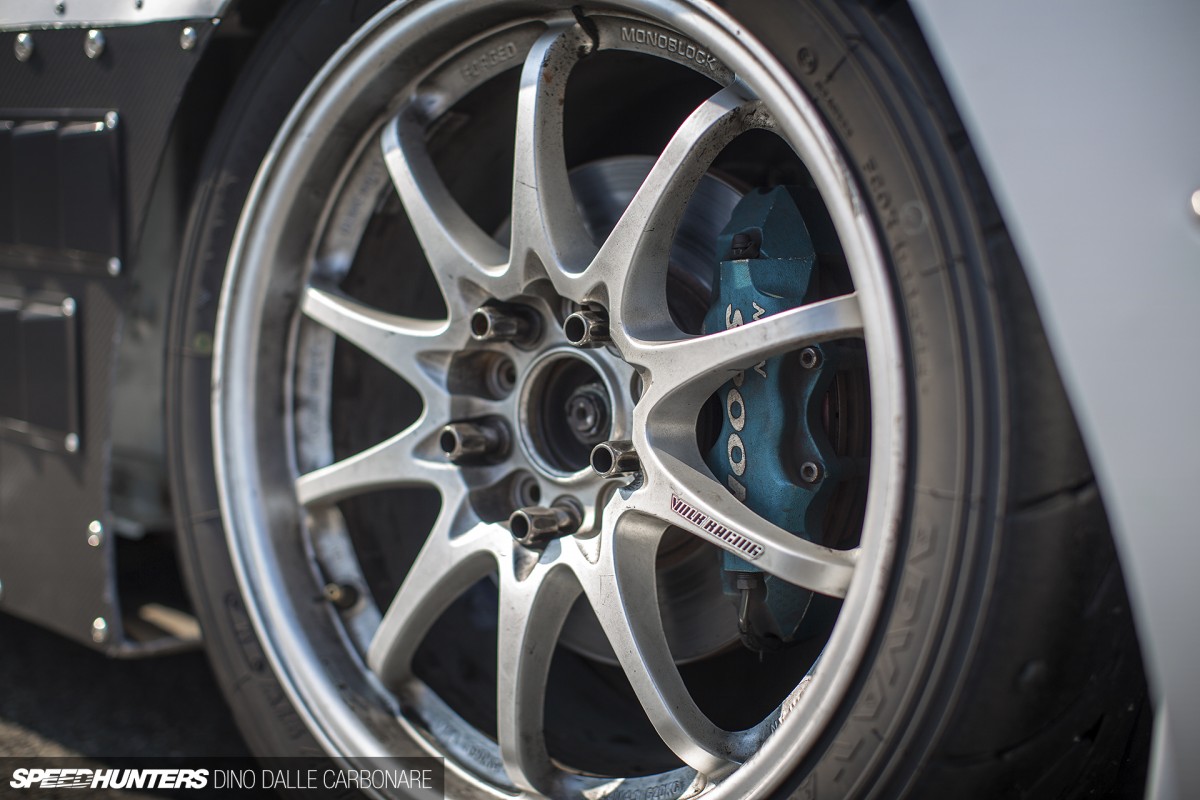
With the front tyres on a FF car having to do double the work than those on a RWD vehicle, it’s no surprise to see a fatter section tyre being run on the 17-inch RAYS Volk Racing CE28Ns – 245/45R17 Advan A050s to be precise. The rear gets the same sort of medium compound rubber, albeit in 205-section and one inch smaller in diameter. On a lightweight car like this outright braking power isn’t much of a concern, but to ensure a solid pedal and a resistance to fade, Spoon-spec Nissin callipers are used at the front end.
Well Chosen Additions
The aero treatment continues with a set of Bomex side skirts, offering a more angular contour and really suiting the new look of the car.
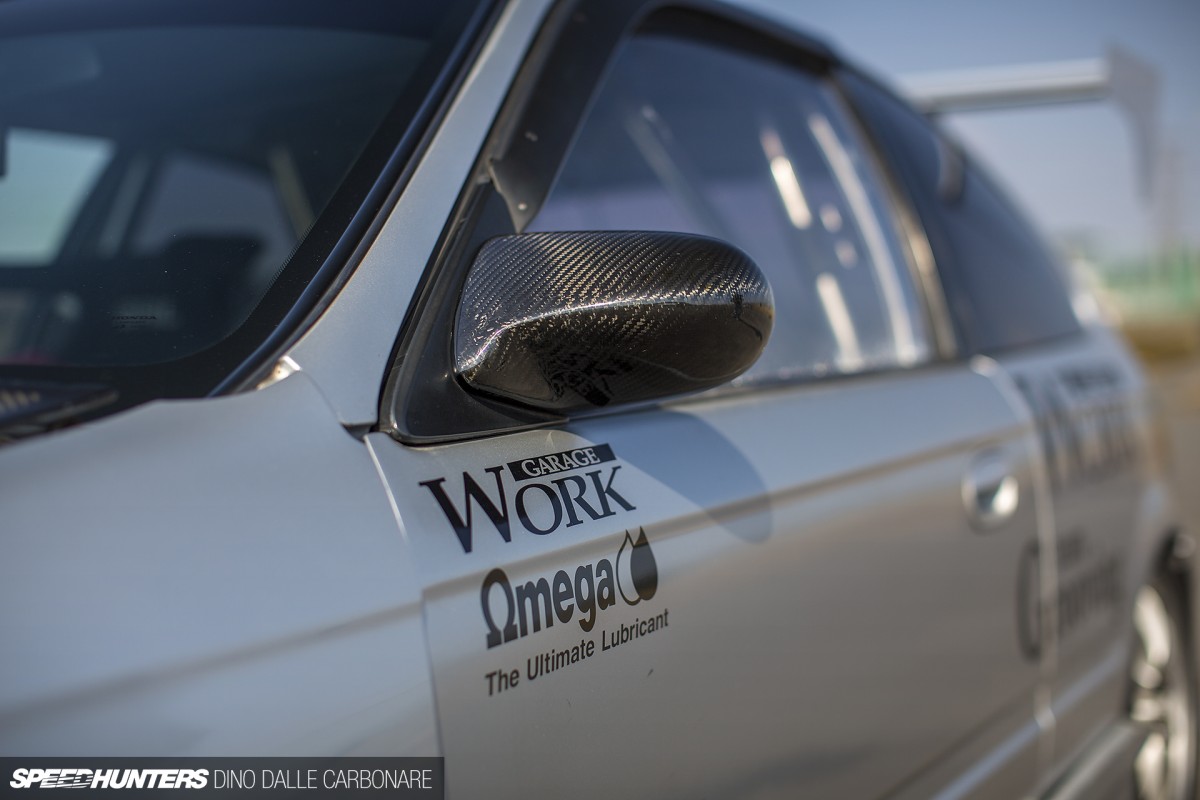
Another item from Spoon Sports are the carbon fiber mirrors – a nice addition which helps shed a little more weight. Even the strips of plastic that protect the doors against car park dings have been removed – because every gram counts on this particular project.

And that’s precisely the overall theme that’s been gone for here. Yes, Makoto’s added some things in an effort to increase performance, but he’s taken away far more to help shed as much mass as possible. It’s another school of thought over the big power, expensive builds we always see at time attack events, but as we all know it yields so much more.

With so much downforce being generated at the front – and with the majority of the weight concentrated there – the need to balance out the rear was very important. That’s why the hatch has been outfitted with a 1500mm GT wing from Techno Pro.

More weight-slashing measures include a Monster carbon bonnet and even a carbon filler cover.

The rear bumper has had slits cut into its ends in an attempt to reduce drag, while an adapted rear diffuser – which looks very similar to the ones that RE Amemiya use on their RX-7s – generates further downforce. The car sits low, not for looks, but because the Garage WORK spec Tein adjustable dampers have been set up with the most aggressive geometry possible. All bushes have been replaced with pillow-ball equivalents to rid the linkages of any play, and a titanium strut tower bar has even been fitted for its rigid but light weight properties.

Makoto-san lifted the single skin, paper-thin bonnet up so I could take a look at what’s providing the power in his Civic. It’s a DOHC VTEC B-series motor, yes, but not the 1.6L unit that was originally specced for the car.
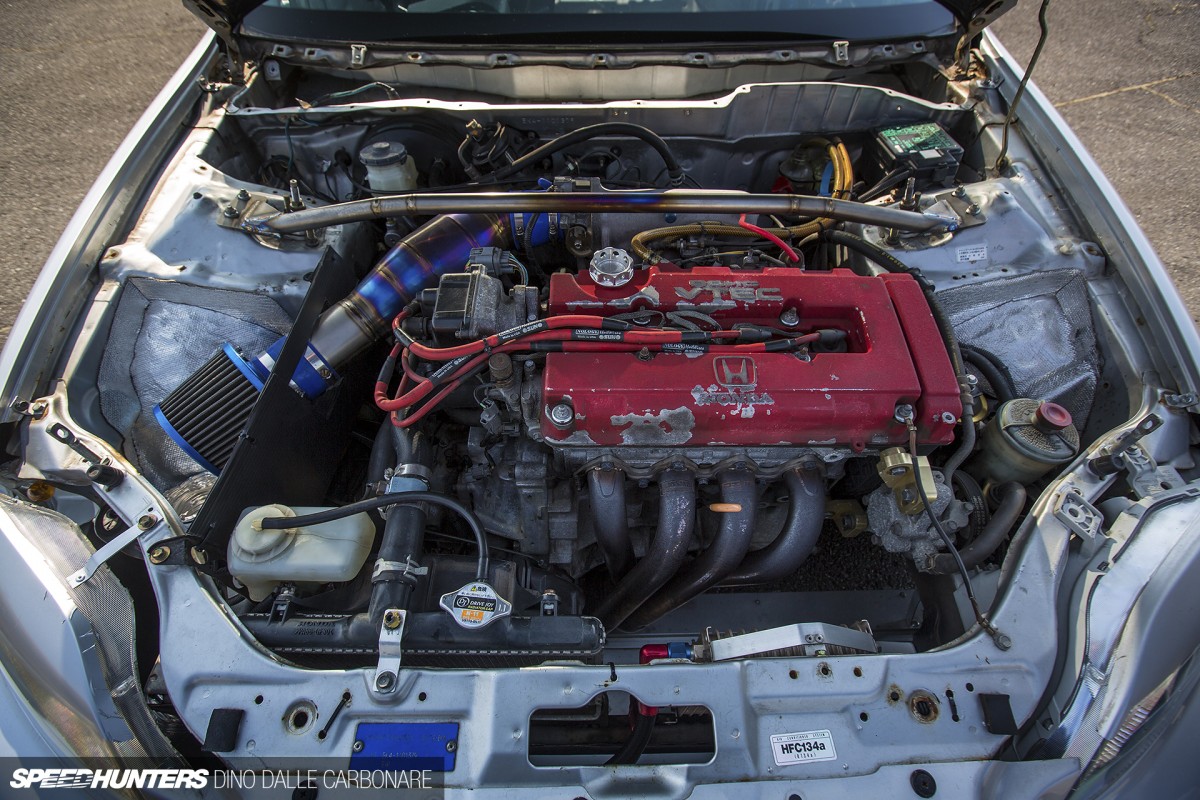
The EK4 was treated to a Integra Type R spec B18C swap – one of the greatest powerplants that Honda has ever created. With 200PS in stock form, it’s just what was needed to add more power without impacting on the car’s balance in any way. It looks rough and well used, and that’s because it is; Makoto saying he’ll eventually get to repainted the cam covers. Maybe.

The stock motor runs some basic upgrades to extract a smidgeon more performance, starting off with this M-Works stainless steel exhaust header.

These connect up to a titanium exhaust system of the same brand with a straight pipe in between. The hand-built system looks and sounds excellent and I’m a big fan of the slightly downturned, lobster-welded tail section.

Nology HotWires ignition leads aid in providing a better conductivity of current from the distributor to the four spark plugs, while a JUN Auto ECU is employed on the engine management side of things to get the best out of the upgrades.

The M-Works titanium intake pipe is by far the nicest addition to the engine bay – a hand-fabricated piece boasting an expansion chamber to help boost the volume of air being swallowed by the engine. To limit restrictions a bigger diameter throttle body was also fitted.

Furthermore, a piece of flex tube helps direct cold air from the front bumper’s left-side intake right towards the air filter, which is boxed away and separated from the rest of the engine bay (completely once the bonnet is closed) through the use of some plastic sheets and a few zipties.
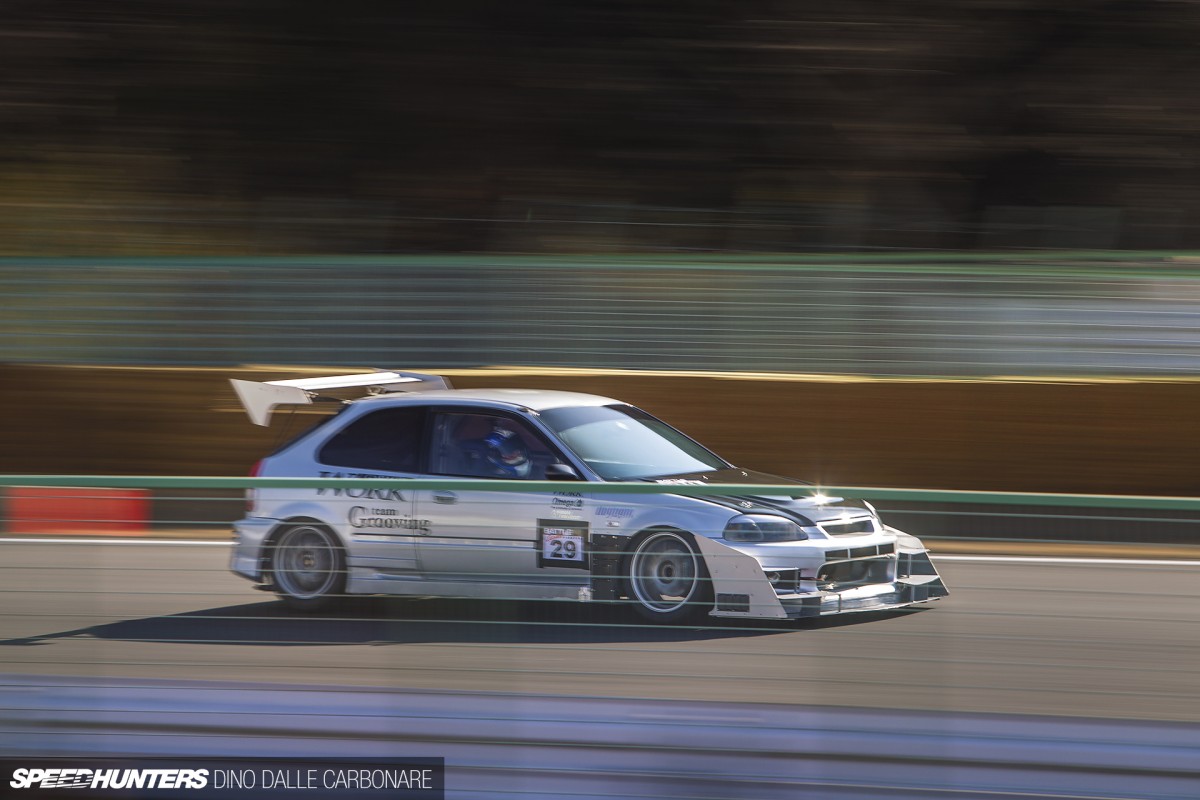
Makoto has never really measured power, so while gains are definitely there, they are minimal on what is already a highly-tuned engine in factory form. Over the EK4’s stock B16A, the real worth is in the way the engine picks up and responds, along with a stronger punch once the wilder profiles on the intake cam kick into action.
Less Is More
As I mentioned earlier though, the real performance benefits have come from the removal of a lot of weight. The EK4 is already a pretty light car to start off with, but after the sort of gutting you see here, the mass has dropped significantly. All the way down to 800kg in fact.
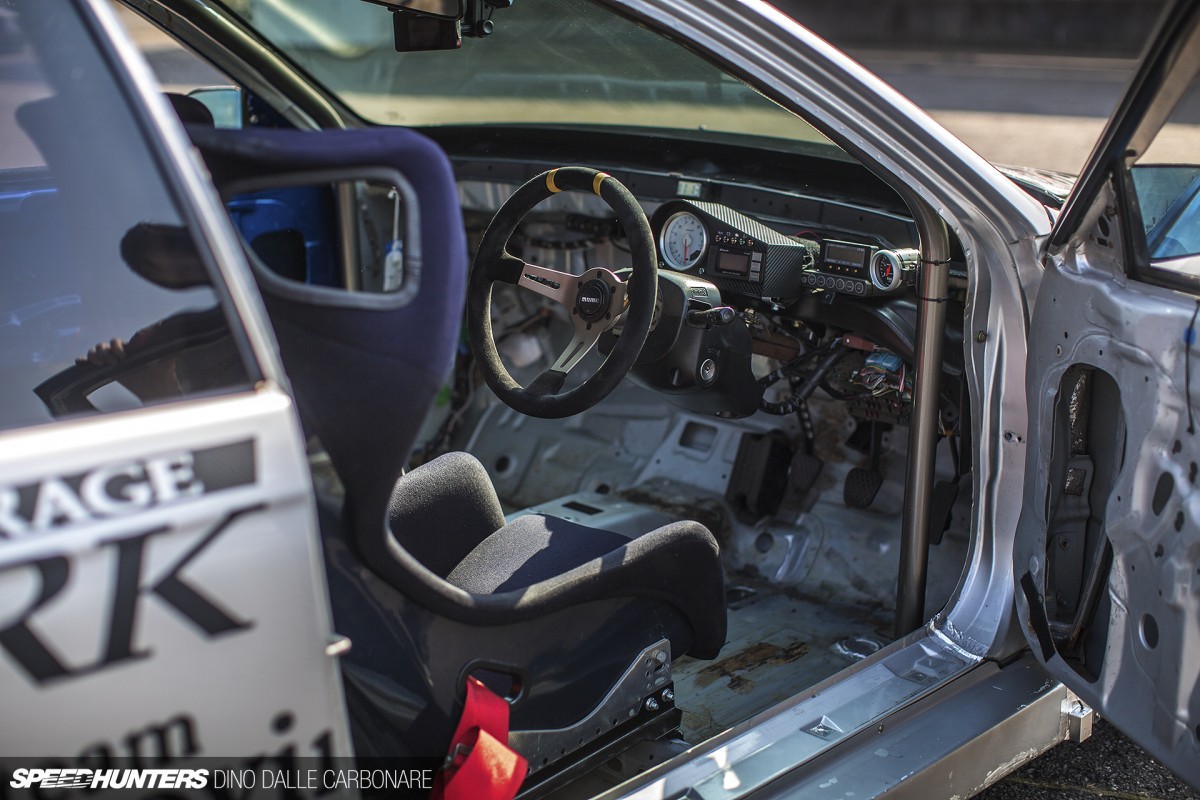
There is absolutely nothing left from the stock interior – just the plastic trim on the steering column, and the pedals. I’m sure the 6-point Saito Rollcage bolt-in cage will have most of our safety-conscious readers cringing, but it has helped stiffen the chassis up a little and will definitely add extra protection in the case of an impact. This, after all, is how things have always been done in Japan when it comes to cages.
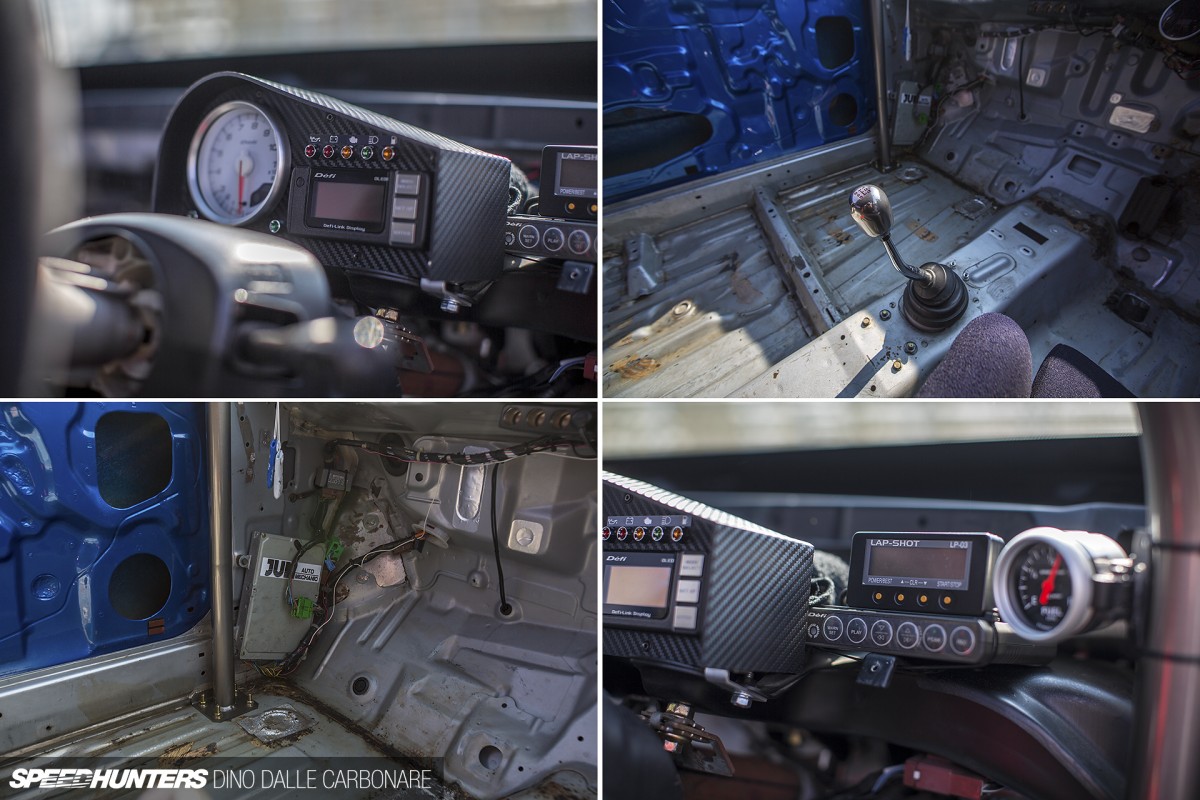
Makoto has created a neat little instrument panel employing Defi instrumentation, starting off with a big tachometer in center position and adding a Link Display to relay a number of readings from the JUN ECU. The lonely stock shift lever actuates the special Garage WORK short-ratio equipped 5-speed gearbox, sending drive to the front wheels through a Cusco 2-way LSD.
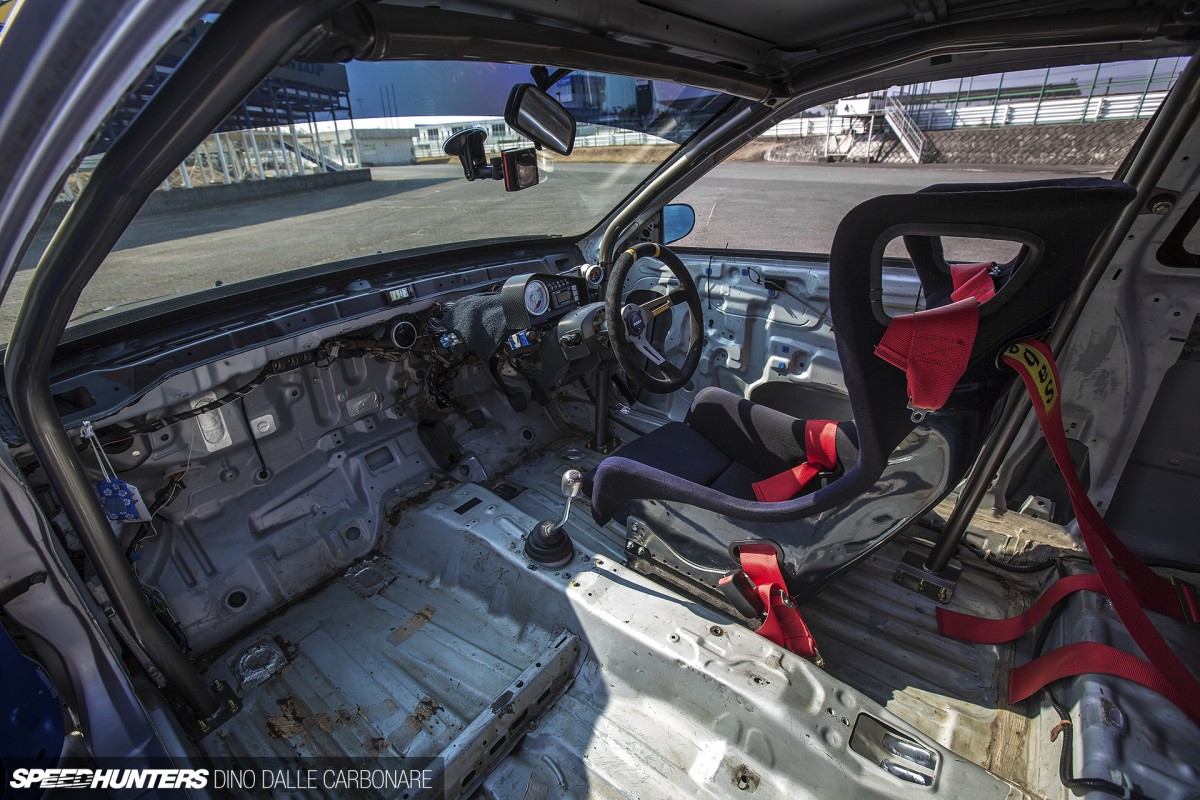
Makoto managed a 1’02″743 lap at the Battle Evome event, which is an impressive time. It’s gone even faster previously though – a 1’01″881 its best to date.
Just for reference purposes, take a look at this old Hot Version video where Keiichi Tsuchiya puts the Spoon Sports EK9 Type R (with a B16B stroked to 1.8L) to the test. It should give you an idea of just how hard you have to drive these FF cars to achieve these sort of lap times.

Makoto is confident the car has a lot more to prove, so he will just keep on trying and driving harder, while enjoying every second he’s out on track. The ultimate goal? That sub-minute lap time at Tsukuba that everyone guns for…
Dino Dalle Carbonare
Instagram: speedhunters_dino
dino@speedhunters.com
Garage WORK Honda Civic SiR EK4
Numbers
Weight: 800kg, Tsukuba Best Lap: 1’01″881
Engine
Honda B18C Type R swap, M-Works titanium suction pipe, large diameter throttle body, M-Works exhaust manifold, M-Works titanium exhaust system, titanium cat replacement pipe, JUN Auto ECU
Driveline
5-speed gearbox, Garage WORK special gear ratios, Cusco RS LSD
Suspension/Brakes
Tein HT adjustable suspension, M-Works titanium strut tower bar, pillowball bushings throughout, Spoon front brake calipers
Wheels
RAYS Volk Racing CE28N 17×8.5-inch (front), 16×7-inch (rear), Yokohama Advan A050 245/40R17 (front), 205/50R16 (rear)
Exterior
C-West front bumper, custom aluminium splitter & canards, Monster carbon bonnet, custom front fenders with vented sides, Bomex side skirts, Spoon carbon mirrors, Techno Pro 1500mm GT Wing
Interior
Saito Rollcage 6-point cage, completely stripped interior, Bride bucket seat, Sabelt harnesses, Momo steering wheel, custom instrument panel with Defi tachometer & Defi Link Display, Defi Control Unit II, Defi oil temperature gauge, Lap Shot II lap timer, Auto Meter Sport-Comp fuel gauge
More Time Attack related car features on Speedhunters
Garage Work Facebook page






In Jeremy Clarkson voice, "Yeeessssss"
The same people that love this, hate the 15' civic type R.
trolololol
Nicholas J OGara Ya, pretty much. Why is that so amusing to you?
Time to upgrade that tired B to a K.
It is comically ironic.
CSAlltrac yessssss. in jeremy clarkson agreement.
johnbezt CSAlltrac lol
Nicholas J OGara Same name, and yeah, that's about it
The fact this is lighter than a elise is astounding.
I think I'm gonna do something like this with my Volvo 850 Turbo when I replace it as my daily driver. Even though they're two totally different cars, there's so much here that transfers, and I love homemade aerodynamics.
I'd rather have something like this than a ready-to-run $100,000 car, because anybody can write a check, and I'd prefer to say that I did it myself.
Pride of ownership.
Absolutely love it shows what you don't need to go fast.
shows what you don't need to go fast.
And that cage.... because Japan
aw318i
Ice Age Well said, you can really take this approach on any car you like
@zz Makes you think uh
Smiggins Nothing wrong with a B-series
What a car! Absolutely fantastic.
I'm pretty sure that the subminute time at Tsukuba is close...
Good job!
speedhunters_dino Smiggins Hell no there isn't! I still have fond memories of winding the B16 in my del Sol VTEC up to 8200 RPM back in the 90's. It just put the 4A-GE in the MR2 I owned before it to shame. If only I could have had the B16 in the MR2, though!
Smiggins Time to go slower, then.
good stuff....
Nicholas J OGara prob because that new "civic" its a bloated pile....this one is from when i had a crush on honda's
Hey, leave your emotional bias out of this.
drooling. How do you make the cones in the intake pipe ???
Always nice to see the Garage WORK guy's seeing some love.
Although, I can assure you the 5Zigen FD2 Civic is in fact a Civic and NOT a DC5 Integra.
5-lug conversion?
Nicholas J OGara Thanks!:D I wonder where i can buy a conical titanium tube ? :S Also i was thinking just to make a straight tube and cut a vortex creator into the tube then cover that section with the induction chamber . Not sure if it would work but it would be cool to think you can make a mini vortex creator turbo pressure system
Nicholas J OGara
Nicholas J OGara I dont get it.
ITRbroham Smiggins Youre saying B series make more power than K's?
speedhunters_dino Smiggins Nothing wrong no, but I was under the impression the engine out of the RSX type S was superior. But I havent really been following that closely.
I think the beginning about function and form is switched...
I love seeing civic articles on speedhunters but I always wonder if Japanese tuners have an aversion to turbo-charged Hondas...I don`t think I have seen a tuned track car featuring a turbocharged engine. In the states it feels like turbo civics are a dime a dozen and all over the place. The use of some "exotic" intake certainly is no match for what forced induction can do with the b-series engines.
Wouldnt his breather setup loose power in an open system because there is no negative pressure in the valve cover on acceleration /////./???
Nicholas J OGara It's not that I hate the 15' Civic Type R (I'm actually quite interested to see how well it drives and performs), but with the move towards
forced induction and its lack of rear independent suspension, I can
understand why some Honda purists, including myself, are happy to see
well-executed old model builds like this that show you don't need to
depend on the compromises being made by OEM's these days to be
competitive. Simply put, there are other ways to achieve progress, and I
often look at Speedhunters as a site that gives much needed coverage
for this kind of alterantive thinking and execution. The fact is, the FN and FK generations have been more like upsized Honda Fit's than actual Civics. Still lots of potential for performance that should be developed, but just isnt the same as a real Civic Type R.